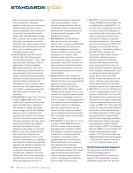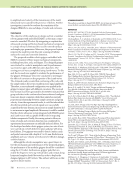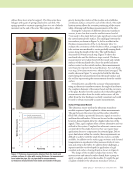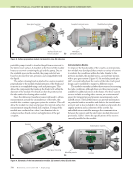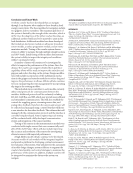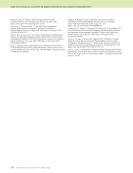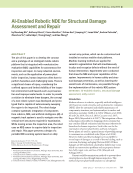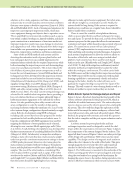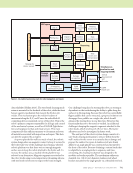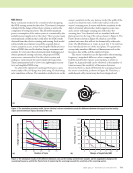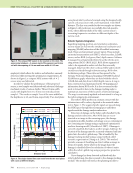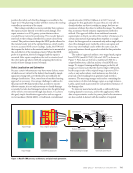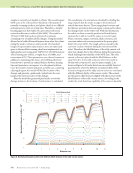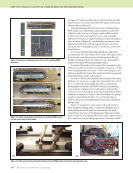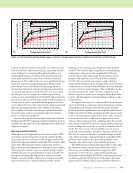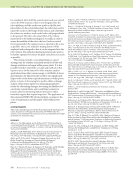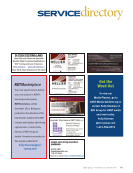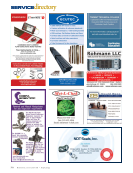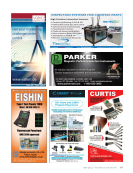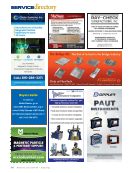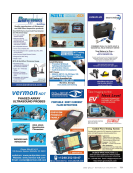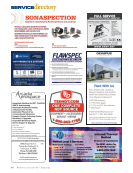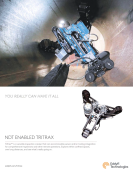692 M A T E R I A L S E V A L U A T I O N • J U L Y 2 0 2 1 pipe rack obstructed measurements on the northeast corner of the stack. During the course of the flights, the engineers had access to the user interface that streamed the UT thickness reading measurements in real time. Additional Data In addition to the UT thickness data collected during the flight of the aerial robotic UT system, HD video was recorded, as were still photos of the UT probe tip in contact with the flare stack as the UT thickness reading was being collected (see Figure 6). In addition to the snapshot photos taken for each measurement location from onboard the aircraft and the snapshot of the aerial robotic system making contact with the flare stack from the camera on the ground, a full HD video from onboard the aircraft was recorded. This video is provided to the client for their use for example, to review it for visual areas of corrosion or to look for surface areas of concern.Localization data is included however, as GPS signals are not accurate, especially when flying close to structures, it is not precise enough for use to match CMLs on the physical geometry of the structure. Data gathered from HD cameras can include visual, multispectral, and other imaging data. Further, additional information can be collected from sensors and devices placed in physical contact with surfaces. As NDE 4.0 is data driven, industrial inspection robotic systems are perfect for enabling it and affording its benefits. Capabilities that these aerial robotic systems make available for NDE 4.0 include aerographic services that utilize 3D and other computer vision various AI, machine vision, computational geometry, simultaneous localization and mapping (SLAM) live 3D point clouds stereoscopic real-time video photogrammetry and other technology innovations. This would include mature and emerging technologies such as the use of AI, machine learning, machine vision, deep learning, big data and smart data processing and visualization, cloud computing, augmented/virtual/mixed reality, blockchains, 5G, quantum computers, special data formats and data storage, and more (Vrana 2020). These aerial robotic systems excel at gathering the data needed to unlock the potential of NDE 4.0. Visual inspection can also enable a look at the air density and detect gas leakage using optical gas imagery camera-based systems. Similar “bolt on” technologies to robotic systems can enhance the data collection component of NDE 4.0, thereby augmenting the UT thickness data collected. Outfitting a drone with an array of multimodal sensory devices collecting a plethora of data and information will enable the best success and use of NDE 4.0 as these systems provide more and better data for analysis. Drawbacks of Industrial Robotic UT Thickness Measurements and Inspections The aerial robotic system described in this paper is not always the ideal solution. In many situations, the existing inspection regime and methods can be completed relatively inexpensively and safely. They provide the requisite data and information for good operations and knowledge of the current and projected future state of the asset. Aerial robots can require a relatively high upfront investment (Global Electronic Services 2021), although on a per-inspection cost basis, the robotic inspections may cost less. These systems are aircraft with electronics onboard and are thus subject to limited operations ME FEATURE w aerial robots for ut thickness measurements Figure 6. An example of flight details: (a) a sample UT thickness measurement reading (UT-6) at condition monitoring location 9 (CML-9) showing the lowest measurement reading out of three readings (N-3) (b) photo of the aerial robotic system making contact with the flare stack from the post-flight report (note all numbers and values are illustrative). (a) (b)
J U L Y 2 0 2 1 • M A T E R I A L S E V A L U A T I O N 693 due to weather. For example, you could not operate one in the rain unless it is specifically designed to be waterproof. Wind is also a limiting factor as gusts, the venturi effect, crosswinds, and low-velocity eddies on structures all can impact their flight and performance. Additionally, robots do not respond well to many unexpected situations. Robots are not as versatile as people and while they may exceed at certain specific tasks—especially repeated programmatic tasks—they might not be able to adapt in unexpected or unantici- pated situations. Since the aerial robotic systems are not human inspectors, they may not discover some issues that an experienced human inspector might. Due to this limitation, companies supplement robotic- powered inspections and examinations with ones completed by people. When properly selected and utilized, aerial robotic inspection systems can assist with creating safer work- places, provide better data to manage assets, and unlock cost savings. While industrial robotic inspec- tion systems can be highly effective when properly used, they do have limitations and, in some cases, they are the incorrect tool. Organizational Benefits of Faster, Safer Robotic UT Thickness Measurements Planned preventative maintenance has long been practiced as a strategy for keeping industrial field assets operating safely and efficiently. This has led to the development of standards to help asset owners maintain the integrity and fabric of their facilities and to ensure that they remain operationally safe and effective for their entire life cycle. Transformative tech- nology such as aerial robotic UT thickness measure- ment and visual asset assessment systems, such as those discussed in this paper, allow customers to take a fresh look at the opportunity for conducting inspec- tions and data-gathering operations that can help redefine a planned maintenance regime. As these systems collect huge amounts of data, they provide a fantastic opportunity to add to or create a digital record of industrial field assets. Investment in a powerful data-collection system via an aerial robotic system is fairly simple and can be easily made purely on a financial footing. Utilizing these systems makes other visual or data inspections redundant, as the aerial robot collects UT thickness measurement data as well as HD video that can be used for visual inspec- tion. The benefits have been clearly shown from the early adopters of this technology. Conclusion Given the enormous potential industrial aerial robotic field inspection systems enable, one can easily envision a future with robotic systems having more automation, functionality, and capability. This would enable more inspections as an increased number of inspection robots are placed in service and as func- tionality increases. The systems presented in this paper improve effi- ciency due to reduced inspection times and increase efficacy by faster reporting and decision making, which adds value and creates even more value when coupled with NDE 4.0 processes. Further, they help achieve substantial cost savings, particularly when they prevent an industrial asset from being taken out of service or enabling the asset to be returned to service faster. And, finally, they are an elegant safety solution moving workers out of harm’s way and potentially saving lives. As we move toward a more automated future with robotic inspection tools becoming more advanced, affordable, and utilized, we will continue to utilize automation tools that free human inspectors from the dirty, dull, and dangerous tasks of collecting inspec- tion data. This will enable them to spend more time on the higher value components of industrial asset operation and maintenance. w As these systems collect huge amounts of data, they provide a fantastic opportunity to add to or create a digital record of industrial field assets.
ASNT grants non-exclusive, non-transferable license of this material to . All rights reserved. © ASNT 2025. To report unauthorized use, contact: customersupport@asnt.org



























































